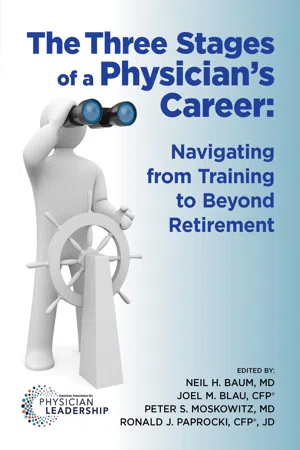
The Three Stages of a Physician's Career
Navigating from Training to Beyond Retirement
- English
- ePUB (mobile friendly)
- Available on iOS & Android
The Three Stages of a Physician's Career
Navigating from Training to Beyond Retirement
About This Book
Today's medical graduates are superbly trained to practice state-of-the art clinical medicine. However, only in rare instances are they trained to self-manage their careers and medical practices. This book fills that gap in training and knowledge. To assist students, interns, residents, fellows, and practicing physicians manage the many challenges of their career, the authors have divided physicians careers into three stages: Early-Career, Mid-Career, and Late-Career.
The goal of this book is to provide a go-to resource on strategic career and practice management, highlighting the unique issues, concerns and challenges doctors face during these three, very different stages of their career from medical school through post-retirement. This book, featuring insights from physician career and practice management experts, is an invaluable treasure trove of practical, hands-on advice from an author team gathering their expertise in one place. Jam-packed with easy-to-implement suggestions, you'll hear sage advice from a career coach for physicians, two certified financial planners, a healthcare attorney, a medical school dean for student advising, two experts who launch, merge, and sell physician practices, and a surgeon who literally wrote the book, on the business aspects of running a medical practice.
All are recognized authorities in their field, and the authors are joined by a distinguished group of contributors including, Randy Bauman, Keith Borglum, Thomas Shapira, and Dr. Neil Gesundheit. The contributors have decades of experience writing about the career and/or practice issues of physicians, and advising physicians and physicians-in-training.
The Early-Career section provides in-depth descriptions of career theory, choosing a medical field, renewing and balancing yourself, managing career transitions, and practical guidelines to navigate the many other challenges of early careers in medicine.
The Mid-Career section offers the broadest and most detailed information available regarding practice organization and management, building assets and retirement planning, estate planning, common legal issues, and how to manage the challenges of malpractice and/or impairment.
The Late-Career section covers deciding what to do after practice, closing the doors or selling a practice, and evolving estate and practice priorities so there is joy in a well-planned retirement filled with fun, meaning, and contribution.
This book will become your go to resource for critical topics such as these:
- Modern Career Theory as it pertains to medical careers
- Defining & managing the 3 types of medical career transitions.
- How to transition to a non-clinical career
- How to choose your area of medical specialization
- Self-Renewal, work-life balance, and the unique balance challenges of students and trainees
- The essentials of landing your first job
Frequently asked questions
Information
Career Transition Theory: The Career Cycle

Phase 1: Go For It
Phase 2: The Doldrums
Phase 3: Cocooning
Phase 4: Getting Ready
Back to the Beginning
Table of contents
- Dedication
- About the Authors
- About the Contributors
- Introduction
- Chapter 1
- Chapter 2
- Chapter 3
- Chapter 4
- Chapter 5
- Chapter 6
- Chapter 7
- Chapter 8
- Managing a Practice or Career Transition
- Chapter 9
- Chapter 10
- Chapter 11
- Chapter 12
- Managing the Unwanted: Malpractice, Disability, and Impairment
- Chapter 13
- Chapter 14
- Chapter 15
- Chapter 16
- Afterword